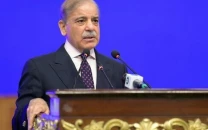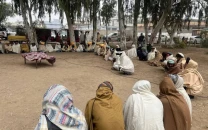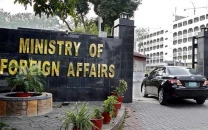The sacred four: The decline of Hindu holy sites in Peshawar
Only Guru Gorkhnath temple remains functional, with others demolished or closed.

This is all that remains of a once sacred site in the city. In pre-partition days, the Panj Tirath complex included ponds, temples, residential complexes and sprawling lawns. PHOTO: RIAZ AHMED/EXPRESS
A signboard hangs near the pool, telling visitors a natural steam runs through it since 1675. For centuries, this stream was more than just a swimming hole to locals. It was among the four most sacred places for Hindus located in Peshawar – Panj Tirath (the five ponds), the centuries-old Guru Gorkhnath temple in Gorghatri, Aasamai temple and Khushal Bagh.

This is all that remains of a once sacred site in the city. In pre-partition days, the Panj Tirath complex included ponds, temples, residential complexes and sprawling lawns. PHOTO: RIAZ AHMED/EXPRESS
However, back then, Khushal Bagh was better known as Gorakh Degi or the pond of Gorakh. For generations, Hindus living in Peshawar and other parts of the province visited the stream to take a bath and wash away their sins in its holy water.
“It is associated with the Guru Gorkhnath temple in Gorghatri. It is said our guru used to jump into the well inside the temple and appear in Gorakh Degi on Warsak Road miles away. So both places are holy for us,” Haroon Sarbdyal, a local Hindu elder told The Express Tribune.
Gorakh Degi, along with most other religious sites in Peshawar, was abandoned after the partition of the sub-continent in 1947 as only the disadvantaged-caste adherents were left on this side of the border. Traditionally, they were only allowed to pray inside their own temples and were prohibited from worshipping at the holiest of sites of the higher-caste Hindus.
The 160-year-old Guru Gorkhnath temple was named after a Hindu spiritual leader Guru Goraknath. After the local Hindu community diminished post partition, the temple remained silent and sans rituals until the Peshawar High Court handed over its custody to the Hindu community early 2012.
The Panj Tirath on the Grand Trunk Road met with a far worse fate. It was razed down and the Khyber-Pakhtunkhwa (K-P) Chamber of Commerce and Industry was built in its place in the 1970s.
“I still remember the ponds of Panj Tirath. I was a student of Government High School City No 2 and was a scout. It was routine for us to cross the road and go to the ponds to practice there,” remarked Zahoor Durrani, who is considered an authority on tourism and the history of K-P.
In his days, the ponds had clean water and an old man would always be present, “who told children the water of Panj Tirath was holy and sacred.”
“I still remember that old man and a milk seller who lived nearby and whose milk was famous in the city. Very good memories of days bygone and a childhood are attached with the pond,” recalled Durrani.

Then suddenly in the 1970s, Durrani added, the ponds were razed and a building called Sarhad Chamber of Commerce and Industry was constructed there. The Asamai temple near Lady Reading Hospital (LRH) remains closed and worshipers are not allowed to enter. Locals claim the temple is one of just two of its kind in the world; a temple of the same name could also be found at the foothills of the Koh-i-Asamai in Kabul.
“As far as my knowledge extends, there are only two historic temples of Asamai – a holy woman. One is located in Peshawar and other in Kabul. It is said the Kabul temple has a jute or flame which has been burning for centuries,” narrated Sarbdyal. “However, both are out of worshippers’ reach these days.”
“Our community was lucky enough. The centuries-old temple in Gorghatri was handed over to us a few years ago,” but, he added, the other two holy sites – Asamai temple and Gorakh Degi – remain under the government’s control.
“Yes, the Panj Tirath is lost forever, but the other two places still exist and should be handed over to the Hindu community,” urged Sarbdyal.
Published in The Express Tribune, June 20th, 2013.






1675249047-0/image-(18)1675249047-0-208x130.webp)












COMMENTS
Comments are moderated and generally will be posted if they are on-topic and not abusive.
For more information, please see our Comments FAQ